
The siege of Leningrad was a military blockade undertaken by the Axis powers against the city of Leningrad in the Soviet Union on the Eastern Front of World War II from 1941 to 1944. Leningrad, the country's second largest city, was besieged by Germany and Finland for 872 days, but never captured. The siege was the longest and most destructive in history and possibly the most deadly, causing an estimated 1.5 million deaths. It was not classified as a war crime at the time, but some historians have since classified it as a genocide due to the intentional destruction of the city and the systematic starvation of its civilian population.

Leonid Aleksandrovich Govorov was a Soviet military commander. Trained as an artillery officer, he joined the Red Army in 1920. He graduated from several Soviet military academies, including the Military Academy of Red Army General Staff. He participated in the Winter War of 1939–1940 against Finland as a senior artillery officer.
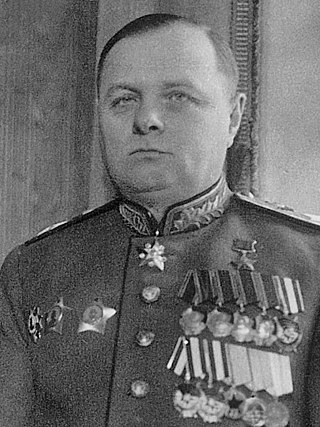
Kirill Afanasievich Meretskov was a Soviet military commander. Having joined the Communist Party in 1917, he served in the Red Army from 1920. During the Winter War of 1939–1940 against Finland, he had the task of penetrating the Mannerheim Line as commander of the 7th Army. He was awarded the title of Hero of the Soviet Union shortly afterwards.
The Battle of Krasny Bor was part of the Soviet offensive Operation Polyarnaya Zvezda in the Eastern Front of World War II. It called for a pincer attack near Leningrad to build on the success of Operation Iskra and completely lift the siege of Leningrad, in the process encircling a substantial part of the German 18th Army. The offensive near the town of Krasny Bor formed the western arm of the pincer. The Soviet offensive began on Wednesday, 10 February 1943, and produced noticeable gains on the first day but rapidly became a stalemate. The strong defense by the Spanish Blue Division and the German SS Polizei Division gave the German forces time to reinforce their positions. By February 13, the Soviet forces had ceased their offensive in this sector.
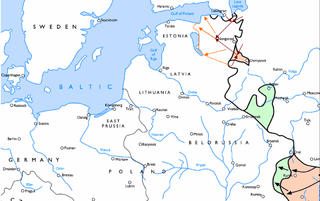
Operation Polar Star was an operation conducted by the Soviet Leningrad, Volkhov and Northwestern Fronts in February and March 1943. The operation was planned by Georgy Zhukov in the wake of the successful Operation Iskra and envisaged two separate encirclements. One was to be carried out in the north by the Leningrad and Volkhov Fronts near Mga and one was planned to be carried out further to the south, by the Northwestern Front, near Demyansk.

Ivan Ivanovich Fedyuninsky was a Soviet military leader and Hero of the Soviet Union (1939).
The Volkhov Front was a major formation of the Red Army during the first period of the Second World War. It was formed as an expediency of an early attempt to halt the advance of the Wehrmacht Army Group North in its offensive thrust towards Leningrad. Initially the front operated to the south of Leningrad, with its flank on Lake Ladoga.

The Leningrad–Novgorod strategic offensive was a strategic offensive during World War II. It was launched by the Red Army on 14 January 1944 with an attack on the German Army Group North by the Soviet Volkhov and Leningrad fronts, along with part of the 2nd Baltic Front, with a goal of fully lifting the siege of Leningrad. Approximately two weeks later, the Red Army regained control of the Moscow–Leningrad railway, and on 26 January 1944 Joseph Stalin declared that the siege of Leningrad was lifted, and that German forces were expelled from the Leningrad Oblast. The lifting of the 900-day-long blockade was celebrated in Leningrad on that day with a 324-gun salute. The strategic offensive ended a month later on 1 March, when Stavka ordered the troops of the Leningrad Front to a follow-on operation across the Narva River, while the 2nd Baltic was to defend the territory it gained in pursuit of the German XVI Army Corps.

The Krasnoye Selo–Ropsha offensive, also known as Operation January Thunder and Neva-2, was a campaign between the Soviet Leningrad Front and the German 18th Army fought for the western approaches of Leningrad in 14–30 January 1944.
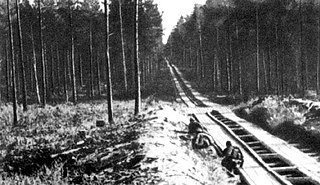
The Sinyavino offensive was an operation planned by the Soviet Union in the summer of 1942 with the aim of breaking the siege of Leningrad, which had begun the previous summer, to establish a reliable supply line to Leningrad. At the same time, German forces were planning Operation Northern Light to capture the city and link up with Finnish forces. To achieve that heavy reinforcements were arriving from Sevastopol, which the German forces captured in July 1942. Both sides were unaware of the other's preparations, and this made the battle unfold in an unanticipated manner for both sides.
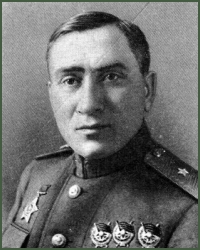
The 305th Rifle Division was formed for the first time as a standard Red Army rifle division shortly after the German invasion. It was soon sent north to the Volkhov Front near Novgorod. In the winter of 1942 it participated in an offensive to try to break the siege of Leningrad which ended with it and most of the rest of the attacking force being cut off and gradually annihilated during the spring. A second 305th was raised a few months later in the southern part of the front, where it distinguished itself in the final liberation of Belgorod. It continued in combat through Ukraine and Poland before ending the war near Prague.
The Red Army's 54th Army was a Soviet field army during the Second World War. It was first formed in the Leningrad Military District in August, 1941, and continued in service in the northern sector of the Soviet-German front until the end of 1944. It spent much of the war attempting to break the German siege of Leningrad, in which it helped to achieve partial success in January, 1943, and complete success one year later. During these operations the soldiers of the 54th served under five different commanders, most notably Col. Gen. Ivan Fedyuninsky in the winter of 1941–42. After helping to drive Army Group North away from Leningrad and into the Baltic states in the first nine months of 1944, the army was deemed surplus to requirements on the narrowing front, and was officially disbanded on the last day of the year.
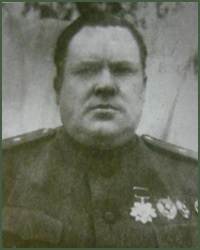
The 310th Rifle Division was a standard Red Army rifle division formed on July 15, 1941 in Kazakhstan before being sent to the vicinity of Leningrad, where it spent most of the war, sharing a similar combat path with its "sister", the 311th Rifle Division. The soldiers of the division fought until early 1944 to, first, hold open some sort of lifeline to the besieged city, then to break the siege and drive off the besieging German forces. They then participated in the offensive that drove Germany's Finnish allies out of the war. Finally, the division was redeployed to take the fight to the German heartland in the winter and spring of 1945. It ended the war north of Berlin with a very creditable combat record for any rifle division.

The 311th Rifle Division was a standard Red Army rifle division formed on July 14, 1941 at Kirov before being sent to the vicinity of Leningrad, where it spent most of the war, sharing a similar combat path with its "sister", the 310th Rifle Division. The men and women of the division were fully engaged in the struggle for Leningrad until early 1944, fighting in several offensives to drive a lifeline through the German positions to the besieged city, and then to finally drive the besiegers away. When this was accomplished, the division was redeployed to take the fight into the Baltic States in 1944, then into the German heartland in the winter and spring of 1945. It ended the war north of Berlin after compiling a very distinguished record of service.
The 374th Rifle Division was raised in 1941 as an infantry division of the Red Army, and served for the duration of the Great Patriotic War in that role. It began forming in August 1941 in the Siberian Military District. It joined the fighting front in December with the new 59th Army along the Volkhov River and it continued to serve in the fighting near Leningrad until early 1944. The dismal fighting on this front gave little opportunity for a unit to distinguish itself, and the division did not finally earn a battle honor until late January 1944, during the Leningrad–Novgorod Offensive. It continued to serve in the summer and autumn offensive through the Baltic States, becoming so reduced in strength that its remaining infantry was consolidated into a single understrength regiment which nevertheless won a battle honor in the liberation of Riga. The 374th ended the war in Latvia, helping to contain and reduce the German forces trapped in the Courland Pocket, and was disbanded shortly thereafter.

The 377th Rifle Division was raised in 1941 as an infantry division of the Red Army, and served for the duration of the Great Patriotic War in that role. It began forming in August 1941 in the Urals Military District. It followed a very similar combat path to that of the 374th and 376th Rifle Divisions. It joined the fighting front in December with the 4th Army, and then briefly came under command of 2nd Shock Army, but soon moved to the 59th Army along the Volkhov River, and continued to serve in this Army's battles near Leningrad until early 1944. The division took very heavy casualties during the Lyuban Offensive in several attempts to relieve the beleaguered 2nd Shock Army. After rebuilding the division held the Army's bridgehead over the Volkhov during 1943, and finally advanced during the Leningrad–Novgorod Offensive in January 1944, taking part in the assault that liberated Novgorod. During the spring the division saw heavy fighting in the battles for Narva before moving south for the summer offensive into the Baltic states. In September it won a battle honor in the liberation of Valga, and in October also received the Order of the Red Banner for its part in the liberation of Riga. The division ended the war in Latvia, helping to contain and reduce the German forces trapped in the Courland Pocket, and was disbanded later in 1945.
The 259th Rifle Division was formed from reservists as a standard Red Army rifle division, very shortly after the German invasion, in the Moscow Military District. It was largely based on what would become the shtat of July 29, 1941. It was assigned to the 34th Army of Reserve Front before the end of July, but this Army was soon reassigned to Northwestern Front. Under these commands it took part in the Staraya Russa offensive operation in August. It suffered significant casualties in its first operation but after falling back toward Leningrad it took part, as part of 52nd Army, in both the defense of Tikhvin and the following counteroffensive that retook the city in one of the first major German reverses. In the new year the 259th was involved in the Lyuban offensive, mostly under command of the ill-fated 2nd Shock Army, and this struggle continued into June. Enough of the division escaped encirclement that it avoided disbandment, and it was sufficiently restored by late August that it was committed to the second Sinyavino offensive, eventually becoming encircled again and forced to break out, at considerable cost. In early October it was withdrawn to the Reserve of the Supreme High Command for a lengthy period of restoration, well into 1943, in 2nd Reserve Army, as it moved well to the south.
The 198th Rifle Division was formed as an infantry division of the Red Army after a motorized division of that same number was reorganized in the first months of the German invasion of the Soviet Union. It was based on the shtat of July 29, 1941, with several modifications. It entered combat as a rifle division during the Tikhvin Offensive in December 1941 as a reinforcement for 54th Army, helping to drive elements of Army Group North back to the Volkhov River from their earlier gains. It would remain near that river line into early 1944. During 1942 it took part in several abortive offensives in an effort to relieve the siege of Leningrad, suffering heavy losses in one of them. In 1943 it was mainly used for line-holding duties at a reduced establishment, in an area where German forces were strictly on the defensive. The 198th was brought back up to something approaching the current establishment by the start of 1944 and, during the offensive that finally drove Army Group North away from Leningrad, it helped to maintain the offensive's momentum following the initial breakthrough as part of 119th Rifle Corps. It was finally reassigned to 3rd Baltic Front's 67th Army in April after it was halted at the Panther Line near Pskov. In August it briefly returned to 54th Army during the advance through the Baltic States, and after the capture of Riga it remained in western Latvia for the duration of the war, serving under several commands, mostly the 42nd and 10th Guards Armies. It was one of the very few divisions that served throughout the war without receiving any battle honors or decorations. Despite this, the 198th continued its service, now in western Siberia, for another 10 years, before being redesignated as the 23rd Rifle Division.
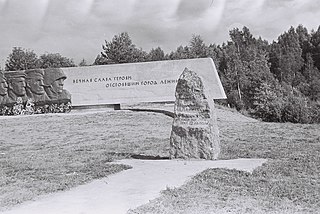
The 191st Rifle Division was an infantry division of the Red Army, originally formed as part of the prewar buildup of forces, based on the shtat of September 13, 1939. It began forming just months before the German invasion at Leningrad. At the outbreak of the war it was still not complete and was briefly held in reserve before being sent south to take up positions as part of the Luga Operational Group. After defending along the Kingisepp axis it was forced to withdraw in late August as part of 8th Army, and helped to establish the Oranienbaum Bridgehead. In October it was ferried into Leningrad itself, but was soon airlifted to 4th Army, which was defending against a German drive on Tikhvin. Although the town fell in November, within a week a counterstroke was begun against the vastly overextended German force, which was forced to evacuate on December 8. As it pursued to the Volkhov River the 191st was awarded the Order of the Red Banner, one of the first divisions so honored during the war. During the Lyuban Offensive it penetrated deep into the German lines as part of 2nd Shock Army, but was cut off, and only fragments of the division emerged from the encirclement in early June, 1942. In September it was committed from reserve in an effort to sustain the Second Sinyavino Offensive, but this failed and the division was again encircled and forced to break out at considerable cost. During Operation Iskra in January, 1943 the 191st played a secondary role in reestablishing land communications with Leningrad, partially raising the siege. The division was relatively inactive as part of 59th Army along the Volkhov during the remainder of the year, but in January, 1944 it took part in the offensive that finally drove Army Group North away from Leningrad and received a battle honor for its role in the liberation of Novgorod. As the offensive continued the division advanced as far as Narva, where it was held up for several months. In late July, it staged an assault crossing of the river and helped take the city, for which one of its regiments also gained a battle honor. Following this victory the 191st advanced into Estonia, gradually moving toward the Latvian capital of Riga. Once this city was taken the division was moved south, and by the start of the Vistula–Oder offensive in January, 1945 it was part of 50th Army in 2nd Belorussian Front, but it was soon reassigned to 49th Army, where it remained for the duration. During the East Pomeranian operation it advanced on Gdańsk, and two of its regiments would later receive decorations for their roles in the campaign. During the final campaign into central Germany the 191st crossed the Oder River before pushing northwest into Mecklenburg-Vorpommern; several of its subunits would receive decorations as a result of this fighting in the final days. The division had a fine record of service that encompassed most of the struggle for Leningrad, but it would be disbanded in July.
The 177th Rifle Division was formed as an infantry division of the Red Army south of Leningrad in March 1941, based on the shtat of September 13, 1939. As Army Group North advanced on Leningrad the division, still incomplete, was rushed south to the Luga area. In mid-July it helped provide the initial resistance to the LVI Motorized Corps which set up the counterstroke at Soltsy, the first significant check of the German drive on Leningrad. In August the German offensive was intensified and the defenders of Luga were encircled and forced to escape northward, losing heavily in the process. A remnant of the 177th reached Leningrad, where it received enough replacements to again be marginally combat-effective. In October to was moved to the Neva River line as part of the Eastern Sector Operational Group. After briefly coming under command of 55th Army it was moved across Lake Ladoga to join 54th Army. It remained in this Army, as part of Volkhov Front, almost continuously until early 1944, serving west of the Volkhov River. It took part in the winter offensive that finally drove Army Group North away from Leningrad and earned a battle honor for the liberation of Lyuban, where part of it had been raised in 1941. Following this victory it was reassigned to 2nd Shock Army in Leningrad Front, and took part in the unsuccessful efforts to retake the city of Narva, before being removed to the Reserve of the Supreme High Command in April for further rebuilding and replenishment. It returned to the fighting front at the beginning of May in 21st Army facing Finland. At the outset of the final offensive against Finland it was in 23rd Army in the Karelian Isthmus. During this operation it advanced through the central part of the isthmus against determined Finnish resistance. The division remained facing Finland until early 1945, when it was moved to Latvia and spent the remainder of the war containing the German forces trapped in Courland, eventually assisting in clearing the region after the German surrender in May. It was moved to the Gorkii Military District in August, and was disbanded there in April 1946.




![Combat situation between the Blue Division (250th Division) and the 305th Rifle Division at the bridgehead at the end of November. North of Shevelevo was the 126th German division. [?]: Relief posts Volkhov bridgehead (south) - 1941.svg](http://upload.wikimedia.org/wikipedia/commons/thumb/d/d6/Volkhov_bridgehead_%28south%29_-_1941.svg/500px-Volkhov_bridgehead_%28south%29_-_1941.svg.png)













